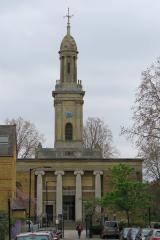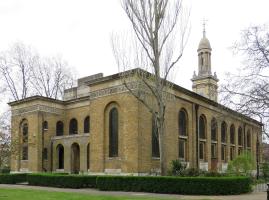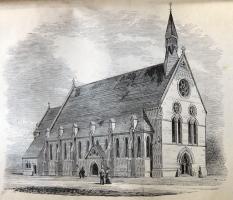 St Peter Walworth, by John Soane, a Waterloo Church.
St Peter Walworth, by John Soane, a Waterloo Church.
 St Peter Walworth, by John Soane, a Waterloo Church.
St Peter Walworth, by John Soane, a Waterloo Church.
St Peter’s Church, Walworth was designed by the notable Classical architect Sir John Soane, who is best known as the architect of the Bank of England.
Walworth Road, leading south from Elephant and Castle in within the borough of Southwark, south London, is interesting to readers of these pages for a group of buildings with sculptural decoration, described on this page. A little way further south, set back from the main road down a little street called Liverpool Grove, is the splendid frontage of St Peter’s Walworth. The entrance, double doors with two side doors, is raised on several steps, and shielded behind four white pillars of the Ionic order which are recessed into the frontage, with a cornice above. Above this is a balustrade, and then the Classical tower, with a square first stage, acting as clock-tower with Romanesque window and side pilasters, then four pinnacles with acorns and a more slender second stage, round in cross section and surrounded by Composite pillars. On top of this, a graceful elongated dome, and then the weathervane on a pedestal. This tower really is the main exterior feature, for the rest of the Church consists of a yellow-brick block, with tall curved windows but otherwise without decoration bar the cornice at front and back. The rear or east end of the Church is recessed in the centre, with an arched screen across it, very Soanian, but there is no disguising that this was a church built economically to pack in the maximum congregation at a price rather than able to afford much decoration. It was in fact built as what was called a Commissioners’ Church, thus one of over 200 churches funded by a £1.5m amount allocated by Church Commissioners, following the 1818 Church Building Act. St Peter’s Walworth was put up in 1823-25. John Soane designed two more churches in London at a similar time – St John’s Bethnal Green, which is not so far away in South London, and Holy Trinity Marylebone.
St Peter Walworth, east end with arcade.
Inside, the Church is light and airy, with galleries to the sides and front below the organ, supported on Doric pillars, and with tall arches supported on octagonal pillars, most delicate. Ewan Christian had a go at the east end in the 1880s, and much of the rest must be restoration as there was WW2 bomb damage, Thomas F. Ford doing the new work and the Church reopening in 1953. Beautifully painted in pale blue and white.
The Church is too recent to expect much by way of monuments, a principal interest of these pages, and the bomb damage probably destroyed much of what was there, but four panels survive in the galleries, and can be appreciated with a visual aid from downstairs, though without getting close I could not see if any were signed by the sculptor-masons who made them. All are from the 1830s, and one has sculpture:
Also in the Church:
Outside, the churchyard has been cleared, and although many tombstones are stacked along one side, they have mostly decayed, the inscriptions unreadable and the minor sculptural decorations lost. A single larger monument, a square pedestal witha a draped pot on top, nothing unusual, survives in situ, surrounded by brambles.
Stacked tombstones from the cleared churchyard.
Two streets along from St Peter’s Walworth is East Street, site of a lively market, and along this street was once the little Church of St Mark Walworth. It was built 150 years after St Peter’s, in 1872-3, aiming to serve the poorest part of Newington, inhabited for the most part by ‘costmongers, fish-curers, labourers, dock porters and shoemakers’, with a strong eye to economy, costing £4,778 to put up, ‘exclusive of heating, lighting and furniture’. The architects were Messrs Henry Jarvis & Son of Trinity Square, who designed the Southwark Municipal Offices just down the road, noted on this page, and who were based not far off in Trinity Square, whose church is noted on this page.
The barbarians demolished the Church in 1956, apparently, but here is a picture. Oddly enough, further down East Street survives the little East Street Baptist Church, built in 1896, with its little spire rather reminiscent of the demolished St Mark’s Church.
 St Mark's Church, Walworth, by Henry Jarvis & Son, demolished.
St Mark's Church, Walworth, by Henry Jarvis & Son, demolished.
Walworth Road Clinic group nearby // South East to St George's Church, Wells Way // Borough to Bermondsey: churches and sculpture
Monuments in some London Churches // Churches in the City of London // Introduction to church monuments
Visits to this page from 12 May 2016: 6,485